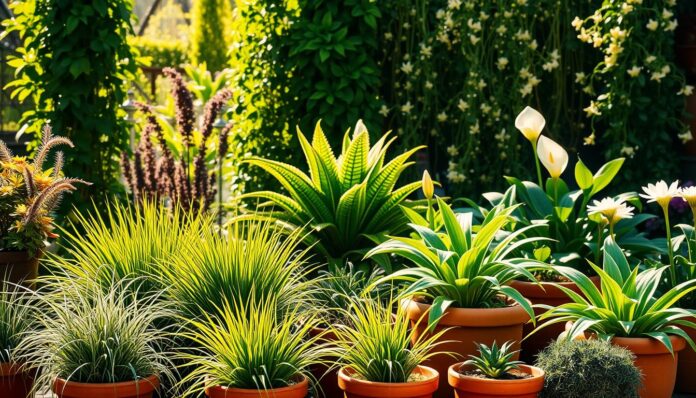Toxic Plants for Pets can pose serious risks to your furry friends, and as a pet owner, it’s crucial to keep your home safe. You take many precautions to protect them, but have you thought about the dangers some plants can pose? Plants like sago palms and lilies can cause serious harm, from mild upset to life-threatening conditions. It’s vital to know these risks and choose plants that won’t harm your pets.
The American Society for the Prevention of Cruelty to Animals (ASPCA) says many plants are toxic to pets. As a responsible owner, it’s key to know which plants are dangerous. By picking safe plants and being careful about what you bring home, you can keep your pets safe and healthy. This article will show you the most toxic plants for pets and how to keep your home safe for them.
Key Takeaways
- Some plants can be toxic to pets, causing a range of symptoms from mild gastrointestinal upset to life-threatening conditions.
- It’s essential to be aware of the potential risks that certain plants can pose to your pets and take steps to create a pet-safe plant environment.
- Choosing indoor plants safe for pets is crucial to preventing harm to your furry friends.
- Toxic plants for pets, such as sago palms and lilies, should be avoided in homes with pets.
- By being mindful of the plants you bring into your home, you can help keep your pets safe and healthy.
- Pet-friendly plants can help create a safe and healthy environment for your furry friends.
- Understanding the risks associated with toxic plants for pets is the first step in protecting your pets from harm.
Understanding the Risk of Toxic Plants for Pets in Your Home
As a pet owner, you want your home to be safe and welcoming for your furry friends. But, many common household plants can be harmful to pet safety. The ASPCA says plants like snake plants and peace lilies can be toxic plants for dogs and poisonous plants for cats. They can cause symptoms from mild stomach upset to serious health issues.
To keep your pets safe, knowing the risks of toxic plants for pets in your home is key. Some common plants that can harm pets include:
- Lily plants, which can cause severe kidney damage in cats
- Sago palms, which can cause liver failure in dogs
- Tulip bulbs, which can cause vomiting and diarrhea in pets
By being careful and choosing safe plants, you can protect your pets. Always check if a plant is safe before bringing it home. Look for pet-friendly alternatives instead.
For more info on poisonous plants for cats and toxic plants for dogs, talk to your vet or visit the ASPCA website. By staying informed and taking action, you can make a safe space for your pets to live happily.
Most Common Toxic Indoor Plants to Avoid
As a pet owner, knowing which indoor plants are toxic is key. The ASPCA lists plants like dieffenbachia, philodendron, and dracaena as harmful. These can upset your pet’s stomach and cause more serious issues. It’s important to pick plants that are safe for your pets.
Some plants to avoid include:
- Dieffenbachia, which can cause oral and gastrointestinal irritation
- Philodendron, which can cause vomiting and diarrhea
- Dracaena, which can cause vomiting, diarrhea, and depression
Safe alternatives for your pets are spider plants, parlor palm, or prayer plants. These plants are non-toxic and can make your home look greener. By choosing wisely, you can keep your home safe for your pets.
Always be cautious about your pet’s safety. If you’re not sure about a plant, it’s best to stay away. With some research, you can make your home beautiful and safe for your pets.
Dangerous Garden Plants That Threaten Pet Safety
When you’re outside with your pets, knowing about poisonous garden plants is key. The ASPCA says many plants, like oleander and azalea, can hurt pets. These toxic garden plants can cause skin issues, allergic reactions, and serious problems if eaten.
To keep your pets safe, it’s important to know which plants to avoid. Some dangerous plants include:
- Oleander: can cause heart problems and shakes
- Azalea: can lead to vomiting, diarrhea, and stomach pain
- Lily: can damage kidneys and cause failure
To make your outdoor area safe for pets, choose non-toxic plants instead. Also, keep plants out of your pets’ reach and watch them closely when they’re outside.
Knowing about poisonous garden plants in your yard helps keep your pets safe. Always put pet safety outdoors first and take steps to protect your pets from toxic garden plants.
Creating a Pet-Safe Plant Environment
As a pet owner, you want your home to be safe for your furry friends. Choosing pet-friendly plants is a great way to do this. The ASPCA lists safe plants for pets, like spider plants and parlor palm, perfect for indoors.
To make your home pet-safe, start by replacing toxic plants with non-toxic ones. You can also keep plants out of your pets’ reach. Using plant covers can also help prevent pets from nibbling on them.
Some popular pet-friendly plants include:
- Spider plants
- Parlor palm
- Peperomia
- Prayer plants
By picking safe plants for pets and keeping toxic ones away, you can ensure a safe space for your pets.
Always be cautious when it comes to your pets’ safety. If you’re not sure about a plant, it’s safer to choose non-toxic plants that are pet-safe.
Conclusion: Maintaining a Pet-Friendly Home Through Smart Plant Choices
Creating a pet-friendly home means watching out for toxic plant risks for your pets. Choose pet-safe plants and avoid hazardous species to keep your pets safe. This way, you can enjoy plants while keeping your pets healthy.
If you love plants or have a new pet, stay alert to toxic plant threats. This article helps you make safe choices for your pets. With a pet-friendly home, you and your pets can live happily together.
FAQ
What are the most common toxic plants for pets?
The American Society for the Prevention of Cruelty to Animals (ASPCA) lists some common toxic plants. These include sago palms, lilies, and castor beans. Also, dieffenbachia, philodendron, and dracaena are on the list.
How can toxic plants affect my pet’s health?
Toxic plants can harm pets in many ways. They can cause mild stomach issues or serious health problems. Symptoms range from vomiting and diarrhea to lethargy and organ failure.
How can I identify toxic plants in my home?
Look for plants with shiny leaves or milky sap. Also, watch out for brightly colored flowers. The ASPCA has a list of safe and toxic plants for pets on their website.
What are some pet-friendly indoor plants I can keep in my home?
Safe indoor plants for pets include spider plants and parlor palms. Boston ferns and cat grass are also good choices. These plants are safe and can be fun for your pets.
How can I create a pet-safe outdoor garden?
Avoid using toxic plants like oleander and azalea in your garden. Instead, choose safe options like lavender and marigolds. Always check your garden for harmful plants and remove them.
What should I do if I suspect my pet has ingested a toxic plant?
If you think your pet ate a toxic plant, call your vet or the ASPCA Animal Poison Control Center right away. Quick action can help prevent serious health problems or save your pet’s life.
For more health tips and wellness advice, explore Negony.com and discover valuable insights to help you live a healthier, happier life.



























